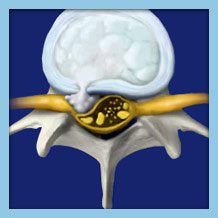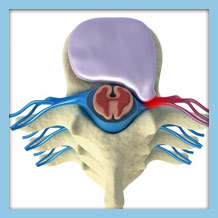

What is a Disc Tear?
Disc tears are a common spinal condition that can significantly impact your quality of life if left untreated. These injuries occur when the tough outer layer of a spinal disc, known as the annulus fibrosus, develops small cracks or ruptures. While the disc acts as a cushion between your vertebrae, damage to this protective layer can lead to pain, mobility issues, and even nerve compression. If the inner gel-like core of the disc, called the nucleus pulposus, leaks through the tear, it can result in more serious conditions, such as a herniated disc.
Timely diagnosis and treatment are essential to prevent further damage and restore spinal health. Whether caused by disc degeneration, traumatic injury, or repetitive strain, torn discs require careful management to alleviate symptoms and support recovery.
Spinal discs play a crucial role in maintaining spinal flexibility and absorbing shock during movement. They are composed of a tough outer layer (the annulus fibrosus) and a soft, gel-like core (the nucleus pulposus). These structures work together to support the vertebrae, allowing smooth motion and stability in your spine. However, when a disc is compromised, such as by an annular tear, it loses its ability to function effectively, potentially causing pain and neurological symptoms.
What is the Right Treatment for Me?
Treating torn discs involves a combination of approaches designed to alleviate pain, restore function, and prevent further damage. Conservative methods, such as physical therapy and medications, are often the first line of treatment. If symptoms persist, advanced interventions like spinal injections or minimally invasive surgeries may be recommended.
OLSS offers a wide range of treatment options. Our board-certified surgeons specialize in state-of-the-art treatments for disc tears, helping patients achieve lasting relief and improved mobility.
The real question is: What treatment is best for your disc tear? Use our Treatment Match tool to quickly get started in finding the right treatment for you.
What Causes Disc Tears?
Disc tears occur due to various factors, with age-related disc degeneration being one of the most common. As spinal discs lose water content and elasticity over time, they become more susceptible to cracks or tears. Traumatic injuries, such as falls, car accidents, or sudden twisting motions, can also damage spinal discs. Additionally, repetitive strain caused by poor posture, frequent heavy lifting, or high-impact sports may gradually weaken the annulus fibrosus, increasing the risk of injury.
Lifestyle choices such as smoking and poor circulation further contribute to disc degeneration by limiting the blood flow needed for disc health. Genetic predisposition may also play a role, making some individuals more prone to developing spinal issues.
Types of Disc Tears
- Cervical Disc Tears: Found in the neck region, these tears often cause neck pain and discomfort radiating into the shoulders and arms.
- Thoracic Disc Tears: Less common, these occur in the mid-back and may lead to localized or radiating pain.
- Lumbar Disc Tears: The most frequently seen type, affecting the lower back, often causing pain that radiates to the hips, legs, or feet.
How Do I Know if I Have a Disc Tear?
Symptoms of a disc tear vary depending on the severity and location of the injury. Common signs include localized pain, numbness, tingling, or weakness in the arms or legs. Cervical disc tears may cause symptoms in the shoulders or arms, while lumbar disc tears typically affect the lower back and legs.
Advanced cases can result in disc herniation, where the inner disc material pushes through the tear, exacerbating pain and potentially compressing nearby nerves. Early intervention is crucial to prevent further complications.
Do you have any of these symptoms? Use our quick tool to determine the problem and get on the road to recovery.
How Are Disc Tears Diagnosed?
Accurate diagnosis begins with a thorough physical examination. Your doctor may evaluate your reflexes, range of motion, and muscle strength to identify signs of nerve compression or spinal instability. Advanced imaging techniques are then used to confirm the diagnosis.
Magnetic Resonance Imaging (MRI) is the most effective tool for visualizing disc tears. It provides detailed images of the intervertebral discs, revealing tears, disc herniation, or other abnormalities.
CT Scans and Myelograms may be used in conjunction to assess the extent of the injury and its impact on surrounding tissues.
Additionally, online resources like the Treatment Match tool available at Orthopedic and Laser Spine Surgery can help patients identify potential symptoms and connect with appropriate care options.
Prompt diagnosis can help prevent further complications and ensure you receive the most effective treatment plan.
What Type of Treatment is Used for a Torn Disc?
Treating torn discs involves a combination of approaches designed to alleviate pain, restore function, and prevent further damage. The choice of treatment depends on the severity of the tear and the patient’s overall health.
Conservative Treatments
Non-surgical or conservative treatments are often the first step in managing disc tears. Rest and adjustments to daily activities are crucial for giving the spine time to heal. Applying heat or ice to the affected area can help reduce inflammation and relieve discomfort. Anti-inflammatory medications may also be prescribed to manage pain.
Physical therapy is a cornerstone of conservative care. Targeted exercises aim to strengthen the muscles surrounding the spine, improving stability and reducing the strain on damaged discs. Over time, these exercises can alleviate disc pain and promote healing.
Advanced Non-Surgical Options
For patients who do not find relief through conservative measures, advanced treatments offer additional solutions. Spinal injections, such as epidural steroid injections, deliver medication directly to the site of inflammation, providing significant pain relief. Platelet-rich plasma (PRP) therapy is an innovative option that uses the body’s natural healing mechanisms to repair damaged tissue.
These minimally invasive techniques are effective alternatives to surgery, offering relief with less recovery time.
Surgical Treatments
When symptoms persist despite non-surgical treatments, surgery may be necessary. At Orthopedic and Laser Spine Surgery, our team specializes in minimally invasive spine surgery, which uses smaller incisions and advanced tools to reduce recovery time and minimize scarring.
Procedures like microdiscectomy or endoscopic discectomy are often used to address annular tears and remove herniated disc material. In cases of severe disc damage, spinal fusion surgery or artificial disc replacement may be recommended to stabilize the spine and restore mobility.
Surgical intervention is always approached with caution and only after all other options have been explored.
Benefits of Early Diagnosis and Treatment
Identifying and treating torn discs early can significantly improve outcomes. Without timely intervention, disc tears can progress, leading to conditions like herniated discs or chronic nerve compression. Early treatment helps:
- Prevent Progression: Addressing the tear promptly reduces the likelihood of developing complications such as disc herniation or spinal instability.
- Minimize Pain: Conservative and advanced treatments can alleviate symptoms quickly, allowing patients to return to their daily activities sooner.
- Preserve Mobility: Maintaining spinal health through physical therapy and other treatments ensures that flexibility and strength are not compromised.
- Avoid Surgery: For many patients, early intervention with non-surgical methods can prevent the need for more invasive procedures.
Taking action at the first signs of a disc tear can dramatically improve your quality of life and reduce the overall impact on your health.
Suffering With a Disc Tear? Take the Next Step With OLSS
At Orthopedic and Laser Spine Surgery, we offer comprehensive care for disc tears, utilizing cutting-edge technology and minimally invasive techniques to provide effective solutions for our patients. Our board-certified surgeons are leaders in their field, specializing in the diagnosis and treatment of even the most complex spinal conditions. With decades of experience and a commitment to personalized care, we help patients achieve lasting relief and improved mobility.
We understand that seeking treatment can be daunting, especially for patients traveling from out of state. That’s why our concierge team is available to assist with coordinating travel, lodging, and other logistics, ensuring a seamless experience. Don’t let a disc tear hold you back—contact us today at (407) 712-8789 or fill out our contact form to start your journey toward recovery.
FAQs About Disc Tears
Can a disc tear heal on its own?
In some cases, minor disc tears can heal naturally over several weeks to months, especially with proper rest and conservative treatments like physical therapy. However, more severe tears or those causing significant symptoms may require medical intervention.
What are the most common symptoms of disc tears?
Symptoms include localized pain near the damaged disc, numbness, tingling, or weakness in nearby extremities. Cervical disc tears often result in neck pain and discomfort in the shoulders and arms, while lumbar disc tears can cause pain radiating to the hips, legs, or feet.
When is surgery necessary for a disc tear?
Surgery is usually reserved for cases where conservative treatments have failed, or symptoms significantly impair daily life. Minimally invasive procedures like microdiscectomy or artificial disc replacement are effective options for addressing severe tears and restoring spinal health.
Can I prevent disc tears in the future?
While not all disc tears are preventable, maintaining good posture, engaging in regular physical therapy exercises, and avoiding repetitive strain can reduce your risk. Additionally, staying active and ensuring proper blood flow to the spine supports overall spinal health.
What is the connection between a herniated disc and a disc tear?
Herniated discs often occur when the inner gel-like material of the disc pushes through a tear in the disc’s outer layer. These tears, if left untreated, may lead to worsening pain and neurological symptoms due to nerve compression.
